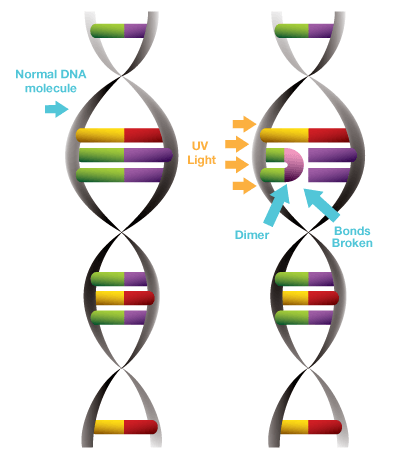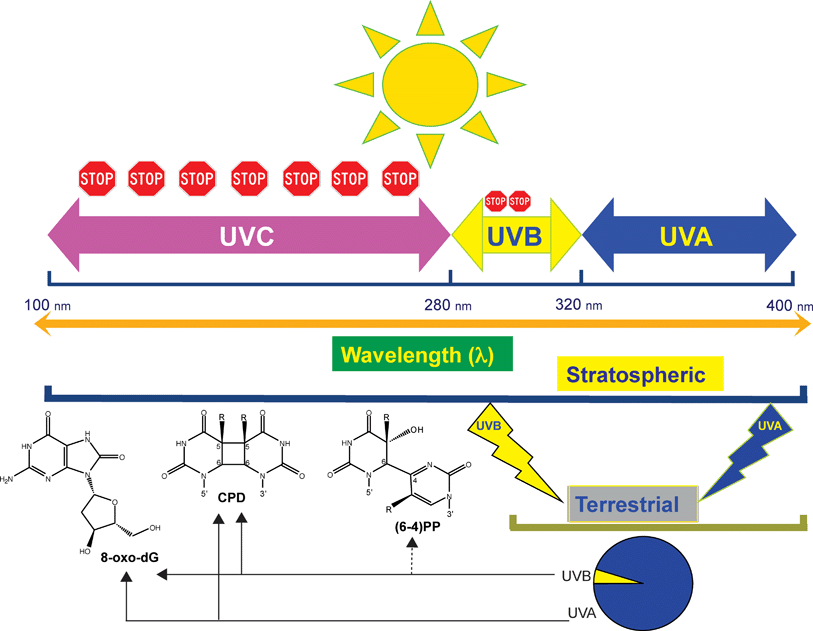
How does sunlight cause DNA damage? What is indirect dna damage? However, it is generally accepted that single oxidized DNA bases (i.e., 8-oxoG) are efficiently and quickly (3–h) eliminated from the genome by the BER pathway.
Once DNA mutation has occurred due to UV. Sunlight, specifically UVB and UVA , triggers various types of DNA damage. Although sunlight, mainly UVB, is necessary for the production of vitamin which is necessary for human health, DNA damage may have several deleterious consequences, such as cell death , mutagenesis , photoaging and cancer.
In actuality, they’re DNA-repairing enzymes that sniff out and repair genetic damage caused by exposure to UV light—damage which, when it accumulates , can lead to skin cancers. An international team of scientists has found that. The immune system immediately sends out enzymes to fix the problem. Enzymes are proteins that act as workers in the body, fixing damage by causing chemical reactions.
This condition mostly affects the eyes and areas of skin exposed to the sun. Some affected individuals also have problems involving the nervous system. Indirect DNA damage occurs when a UV-photon is absorbed in the human skin by a chromophore that does not have the ability to convert the energy into harmless heat very quickly. Damage to cellular DNA is involved in mutagenesis and the development of cancer.
The DNA in a human cell undergoes several thousand to a million damaging events per day, generated by both external (exogenous) and internal metabolic (endogenous) processes. Changes to the cellular genome can generate errors in the transcription of DNA and ensuing translation into proteins necessary for signaling and cellular function. Genomic mutations can also be carried over into daughter generations of cells if the mutation is not repaired prior to mitosis. Once cells lose their ability to effectively repair damaged DNA , there are three possible responses (see Figure 1).
The cell may become senescent, i. Sufficient DNA damage may trigger an apoptotic signaling. See full list on sigmaaldrich. For many years, exogenous sources of damage have been thought to be the primary cause of DNA mutations leading to cancer. However, Jackson and Loeb proposed that endogenous sources of DNA damage also contribute significantly to mutations that lead to malignancy. Both environmental and cellular sources can result in similar types of DNA damage.
DNA can be attacked by physical and chemical mutagens. UV radiation produces covalent bonds that crosslink adjacent pyrimidine (cytosine and thymine) bases in the DNA strand. Ionizing radiation (X-rays) initiates DNA mutations by generating free radicals within the cell that create reactive oxygen species (ROS) and result in single-strand and double-strand breaks in the double helix. While the cell is able to evolve into either an apoptotic or senescent state, these actions are performed as a last resort.
For each type of DNA damage, the cell has evolved a specific method of repairing the damage or eliminating the damaging compound. The reaction is not a catalytic (enzymatic) reaction but is stoichiometric (chemical), consuming one molecule of MGMT for each adduct removed. Cells that have been engineered to overexpress MGMT are more resistant to cancer, likely because they are able to negate a larger amount of alkylating damage. A recent study by Niture, et al.
DNA polymerases such as polymerase-δ contain proofreading activities and are primarily involved in replication error repair. Base excision repair (BER) involves multiple enzymes to excise and replace a single damaged nucleotide base. When an error is detec. The base modifications primarily repaired by BER enzymes are those damaged by endogenous oxidation and hydrolysis.

A DNA glycosylase cleaves the bond between the nucleotide base and ribose, leaving the ribose phosphate chain of the DNA intact but resulting in an apurinic or apyrimidinic (AP) site. Oxoguanine DNA glycosylase I (Ogg1) removes 8-dihydro-8-oxoguanine (8-oxoG), one of the base mutations generated by reactive oxygen species. Polymorphism in the human OGGgene is associated with the risk of various cancers such as lung and prostate cancer. N-Methylpurine DNA glycosylase (MPG) is able to remove a variety of modified purine bases. The AP sites in the DNA that result from the action of BER enzymes, as.
Double-strand breaks in DNA can result in loss and rearrangement of genomic sequences. These breaks are repaired by either nonhomologous end-joining (NHEJ) or by homologous recombination (HR), also called recombinational repair or template–assisted repair. This mechanism requires the presence of an identical or nearly identical sequence linked to the damaged DNA region via the centromere for use as a repair template.
Non-homologous end-joining (NHEJ) is used at other points of the cell cycle when sister chromatids are not available for use as HR templates. While DNA damage is a key factor in the development and evolution of cancer cells, continued damage is used as part of clinical treatments for cancer, forcing malignant cells into apoptosis or senescence. Many chemotheraputic drugs such as bleomycin, mitomycin, and cisplatin, are effective because they cause further DNA damage in cancer cells that replicate at a faster rate than surrounding tissue. In order to block this survival mechanism within cancer cells, clinical trials are now being performed using inhibitors to specific DNA repair enzymes, including MGMT, PARP, and DNA -PK. Sunlight , specifically UVB and UVA, triggers various types of DNA damage.
Although sunlight , mainly UVB, is necessary for the production of vitamin which is necessary for human health, DNA damage may have several deleterious consequences, such as cell death, mutagenesis, photoaging and cancer. Conclusions: We showed that increase in intensity of sunlight in human daily life increased levels of DNA damage. We also showed a protective effect of skin pigmentation on sunlight exposure–mediated DNA damage.
Angela Lamb, director of the Westside Mount Sinai Dermatology Faculty Practice in New York, said. Additionally, according to Solomon, the sun can cause dry skin, actinic keratosis and changes to the skin’s collagen production, resulting in fine lines and deeper wrinkles. Too Much Sun Exposure Can Alter Your DNA ! Do you want to know how much Sun exposure is good for you?
Too much Sun exposure can alter your DNA. CONCLUSIONS: We showed that increase in intensity of sunlight in human daily life increased levels of DNA damage. Symptoms may include a severe sunburn after only a few minutes in the sun , freckling in sun exposed areas, dry skin and changes in skin pigmentation. Normal cells are usually able to fix DNA damage before it causes problems.
However, in people with xeroderma pigmentosum, DNA damage is not repaired normally. Xeroderma pigmentosum is caused by mutations in genes that are involved in repairing damaged DNA. DNA damage arises from both endogenous sources such as water and oxygen and exogenous sources such as sunlight and tobacco smoke.
In human cells, base alterations are generally removed by excision repair pathways that counteract the mutagenic effects. Discover More about your Paternal Ancestry and Connect with Your Y- DNA Relatives.
No comments:
Post a Comment
Note: Only a member of this blog may post a comment.